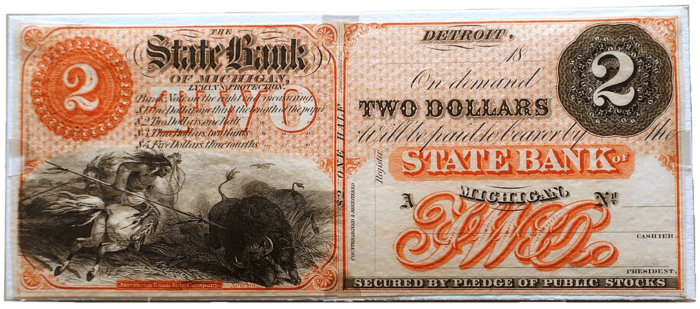Despite Bipartisan Support, Public Banking in Michigan Spurs Skepticism
Fresh proposals can inform the debate about public banking in California. Toward that end, Pando Populus invites leading and original thinkers to express opinions. This is the fourth in a series of articles exploring the topic from a wide variety of perspectives. In part one, S. L. Mintz discusses whether and how public banking could work. In part two, Thorsten Beck examines the intersection of government and banks. Part three looks at public banking and the Garden State. In part five, Mintz considers some of the benefits and the risks of public financing models.
Public banks have lured surprising allies to an idea with socialist roots. Democrat and Republican legislators in Michigan have rallied around a bill that would funnel tax revenues into a state bank owned by the people. If the proposal becomes law and goes as hoped, the Wolverine state would form the first successful public bank since the Bank of North Dakota opened its doors in 1919.
Bipartisan advocates tout familiar reasons to operate banks under the people’s banner. “This is a fiscally responsible solution for taxpayers,’ declared Michigan state representative Martin Howrylak, a Republican bill sponsor with a master’s degree in accounting from the University of Michigan. Commercial banks charge hefty fees and interest rates for needed investment. Public banks, absent a profit motive, could charge less. “As states are looking for ways to reduce spending, many are exploring the idea of a state-owned bank, similar to the Bank of North Dakota.”
According to a press release from Howrylak’s office, the legislative package would:
- Establish the Bank of Michigan and authorize it to receive state tax revenue.
- Create an advisory board for the bank composed of seven members appointed by the governor, which will include representatives from the private banking industry.
- Provide oversight by allowing an Auditor General to audit the bank and prepare an annual financial report. The Department of Insurance and Financial Services will also be responsible for reviewing the bank’s operations at least once every two years and will have authority to investigate.
- Permit the Community Bank of Michigan to lease and sell state-acquired property or partner with other banks and make loans to Michigan farmers; nonprofits using funds for rural business development; parks or recreational properties owned by the Department of Natural Resources that are in need of construction, reconstruction, renovation or maintenance; and government medical facilities for financing.
An appealing vision of revitalized infrastructure investment and small business loans at friendly interest rates and rock bottom fees mobilizes supporters in both parties. “Local governments and schools use these savings to pump more money into classrooms, expand access to infrastructure funding and keep tax rates low,” according to the release.
A public bank would wrest billions of dollars in deposits from dominant big banks in Michigan where giant JP Morgan tops the list, followed by Comerica, PNC Bank, Bank of America and Fifth Third Bank. The top five banks command almost 60 percent of all deposits in the state. Only Comerica has roots in Michigan, where about half of its deposits reside.
Recapturing tax revenues in a state bank sounds to fans like a solution. To finance professor Andrei Simonov at Michigan State University, however, it sounds perilous. A giant pot of money susceptible to political motives alarms him, notwithstanding an auditor general and other assurances of insulation. “I would love to be convinced that politicians can run banks,” says Simonov, “but everything in me tells me it cannot be done.”
Even free of political influence, a Michigan public bank looks risky to Simonov, a widely published expert on global stock markets, institutional and individual investors, investment banking and behavioral finance. Most of the time, the real problem is that the business propositions are not very good. How will a public bank cope? Hide losses under the social thing to do? “The benefits are limited.” says Simonov. “The downside is potentially unlimited.”
Like counterparts elsewhere, borrowers in Michigan have a tough time attracting capital for small business, let alone urgent investment in roads, bridges, airports, water supply and other infrastructure projects, but not for lack of banks. In 2017, there were 126 FDIC insured banks in the state. A robust private sector banking network promotes competition that tends to drive profits down and efficiency up.
A public bank outside this competitive fray would require an unfair advantage over smaller lenders while not being able to match the advantages of scale that global banks enjoy. In order for a public bank to succeed, lawmakers may have to tip the playing field by rolling back the rules and protections that constrain lending by private sector banks.
Instead of trotting out the Bank of North Dakota as a shining success, Simonov warns, treat the Government Development Bank (GDP) of Puerto Rico as a cautionary tale. Launched as the primary fiscal agent for Puerto Rico in charge of deposits from government agencies and municipalities, GDP fell victim to poor judgment and mismanagement. In 2017, an oversight board approved a plan to liquidate $5 billion in debt at losses reportedly up to 45 percent for some bondholders.
Don’t mistake causality, says Simonov. Problems that rendered Puerto Rico ill equipped to cope with a catastrophic hurricane Maria started with disastrous public financing, not vice versa. If ill-conceived investments trigger political wrangling, he warns, a solid credit rating today might not insulate Michigan taxpayers from adverse consequences.
